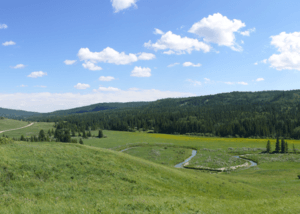Cypress Hills Massacre facts for kids
Quick facts for kids Cypress Hills Massacre |
|
|---|---|

Site of the Cypress Hills Massacre
|
|
| Location | Saskatchewan, Canada |
| Nearest city | Maple Creek No. 111 |
| Year of event | 1873 |
| Designated | 1 January 1964 |
The Cypress Hills Massacre was a sad event that happened on June 1, 1873. It took place near Battle Creek in the Cypress Hills area. This region is now part of Saskatchewan, Canada.
The event involved a group of American bison hunters and wolf hunters, also called "wolfers." There were also American and Canadian whisky traders and Métis cargo haulers. They met a camp of Assiniboine people. During the conflict, at least thirteen Assiniboine warriors and one wolfer died. This tragic event made the Canadian government quickly create and send out the new North-West Mounted Police.
Contents
What Happened After the Massacre?
News of the Cypress Hills Massacre reached Ottawa, Canada's capital, in late August 1873. Because of this delay, many people in Canada did not know about the event right away. The Canadian government wanted to bring those involved from the United States to Canada. They wanted to try them for murder, which caused some tension between Canada and the United States.
The case took a long time to move forward. The newly formed North-West Mounted Police (NWMP) eventually took over the investigation. The NWMP was just starting up at this time. The conflict at Cypress Hills was one of the main reasons this police force was created.
Trying to Find Justice
In December 1874, Assistant Commissioner James Macleod of the NWMP got permission. He was allowed to go to Helena, Montana Territory in the U.S. to start investigating the Cypress Hills Massacre. If his investigation found enough proof, the people accused could be sent to Canada. There, they would face trial under Canadian law.
Seven people were arrested, but two of them escaped before they could be questioned. The remaining people were set free. This happened because there was not enough clear evidence against them. The American official in charge refused to send them to Canada. He said there were too many different stories about what happened. Later, Commissioner Macleod was accused of making false arrests, but this charge was soon dropped.
In June 1876, two traders and a wolfer who had been released in the U.S. crossed into Canada. They were arrested again and put on trial in Winnipeg. However, the case against them failed. There was still not enough clear or consistent evidence. The three men were found not guilty, and the case was finally closed in 1882.
How the North-West Mounted Police Started
It is hard to fully understand how much the Cypress Hills Massacre affected Canada and the United States. The creation of the North-West Mounted Police (NWMP) was partly a direct result of this massacre. The NWMP later became the Royal Canadian Mounted Police (RCMP).
Around this time, the Lieutenant Governor of Manitoba, Alexander Morris, was worried. He feared violence against Canadian and American teams doing land surveys. Because of this, Morris had to stop all surveying until a solution was found. When he couldn't find one, Morris used the reports of the massacre. He asked the Prime Minister of Canada, Sir John A. Macdonald, to create a police force.
Prime Minister Macdonald was already planning to set up a police force in the Northwest Territories. He imagined a police force on horseback, like the Royal Irish Constabulary. This force would be small, with only 300 men. For an area of 480,000 square kilometers, the police force needed to be able to move around easily.
Alexander Campbell, the Minister of the Interior, did not think sending an armed police force was needed yet. This made Morris worry that any delay would be worse once winter arrived. To make sure the police force was created, Morris claimed that the Métis and white settlers near Portage la Prairie and Fort Qu'Appelle were scared because of the massacre.
On September 25, 1873, the Canadian government officially approved the creation of the "Mounted Police Force for the North-West Territories." They started recruiting officers right away, and the North-West Mounted Police was formed. With this new police force patrolling the area, it became much harder to cross the border illegally.
The creation of the police force also had a political reason. The investigation into the massacre was meant to show First Nations people in the area that they could trust the Canadian government. The investigation needed both the Canadian and U.S. governments to work together. The North-West Mounted Police would also make examples of international criminals. Even though no one was ultimately punished, Canada's effort to seek justice helped build peace between the NWMP and First Nations.
Over time, the Cypress Hills Massacre became a known part of Canada's history. Even though the case was never fully resolved, its impact on the creation of Canada's national police force was very important.
Images for kids



